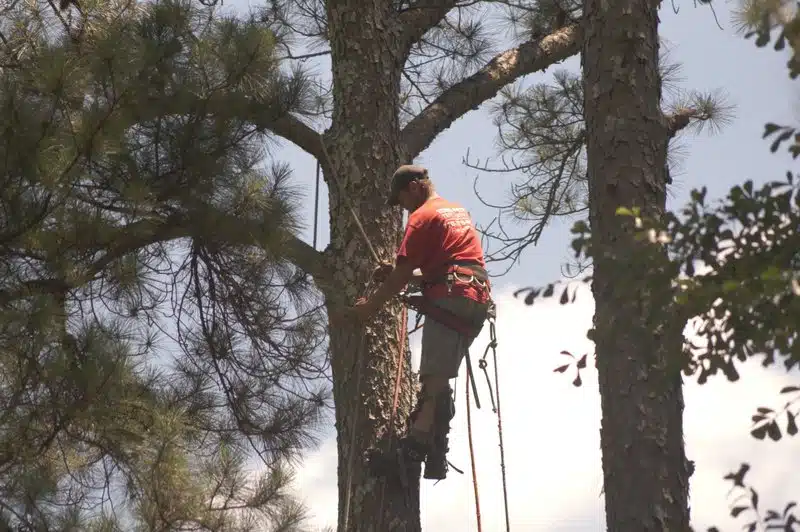Mistletoe, often associated with festive holiday traditions, is a parasitic plant that can harm trees by sapping their nutrients and weakening their structure. While it might be charming during the holiday season, allowing mistletoe to flourish on your trees year-round can have detrimental effects on their health and longevity.
Effectively removing mistletoe from trees requires a combination of knowledge and careful action. It’s essential to address this issue promptly to prevent further damage to your trees and promote their well-being. In this guide, we will explore various methods for removing mistletoe, from manual pruning to chemical treatments, and provide insights into the best practices to ensure your trees remain healthy and free from the grasp of this parasitic plant.
Why Removal of Mistletoe Is Important?
Mistletoe removal from trees is essential for various reasons. Mistletoe is a parasitic plant that attaches itself to the branches and trunks of trees, piercing their vascular systems to drain out nutrients and water. This parasitic connection can weaken and stress the host tree over time, making it more susceptible to diseases, pests, and structural instability.
Mistletoe infestations can cause the host tree to weaken and eventually die if left untreated. Furthermore, mistletoe produces seeds that birds disperse, increasing the likelihood of infestations in nearby trees.
Mistletoe removal is critical not only for protecting the health and longevity of individual trees but also for avoiding the spread of this parasitic plant to other trees in the vicinity. Mistletoe management is an important element of tree care and adds to the general health of your environment.
When Is the Best Time to Remove Mistletoe?
The type of mistletoe and the climate in your area determine the best time to remove it from trees. Mistletoe removal is most effective when done during the dormant season, which is often late fall or winter. Here are a few reasons why this time is advantageous:
During the dormant season, the leaves of both the host tree and the mistletoe are generally thin or missing. This makes it easy to find and remove mistletoe.
Pruning mistletoe during dormancy is less traumatic on the host tree. Removing mistletoe when the tree is actively growing might cause additional stress, potentially resulting in unneeded harm.
Removing mistletoe before it produces seeds helps prevent the plant from spreading to other trees in the region.
Tools and materials needed:
- Pruning shears or pruning saws
- Ladder (if necessary)
- Safety gear (gloves, safety glasses)
- Bag or container for collecting mistletoe
How to Remove Mistletoe from Trees?
Removing mistletoe from trees requires a careful and systematic approach to ensure both the effective removal of the parasitic plant and the health of the host tree. Here’s a step-by-step guide on how to remove mistletoe:
- Put on your protective equipment, such as gloves to protect your hands from harmful allergies and safety glasses to protect your eyes.
- Examine the tree’s limbs and canopy closely to find mistletoe bunches. Mistletoe is commonly observed as green, leafy bunches growing directly on the limbs of a tree.
- Begin with one mistletoe-infested branch. To avoid overstressing the tree, it’s best to remove mistletoe from one limb at a time.
- Make a clean cut with your pruning shears or pruning saw as close to the point where the mistletoe stem links to the host branch as possible. To guarantee full removal, cut at least a few inches beyond the place of attachment.
- Collect each mistletoe cluster as you remove it from a bag or container. This is necessary to keep mistletoe from falling to the ground and maybe spreading to other portions of the tree or other trees.
- After removing mistletoe from one branch, thoroughly inspect the rest of the tree to locate and treat any further contaminated regions.
- Continue this technique, branch by branch, until you have eliminated all visible mistletoe clumps. It may take some time, especially if the tree is badly affected.
- Once you’ve collected all of the mistletoe, dispose of it in a way that ensures it won’t reappear on other trees. Composting and burning are both feasible solutions.
- Inspect the tree on a regular basis for fresh mistletoe growth, especially during the dormant season when mistletoe is more visible. To avoid future spreads, eliminate any new infestations as soon as possible.
Chemical removal of mistletoe
Glyphosate-based herbicides are frequently used to control mistletoe. Glyphosate is a systemic herbicide that can be sprayed directly onto the foliage or stems of mistletoe. The mistletoe absorbs it, and it spreads throughout the plant until it eventually reaches and kills the plant’s roots. Roundup is one example of a glyphosate-based herbicide.
Apply the pesticide during the growing season of mistletoe, when it is actively translocating nutrients from the host tree. This is usually in the late spring or early summer.
Spray the herbicide directly into the mistletoe clusters to ensure complete coverage of the leaves. Be careful not to overspray on the host tree, as glyphosate can potentially kill the tree if absorbed.
It is critical to be informed of the potential environmental impact and regulatory regulations regulating the use of herbicides in your area. Glyphosate, for example, has come under fire for its possible impact on non-target flora and wildlife.
Given the risks and difficulties of chemical mistletoe removal, it’s best to consult with a trained arborist or tree care professional who can analyze the issue and advise on the most appropriate and environmentally responsible technique.
FAQs
Is it essential to remove mistletoe from trees?
Yes, removing mistletoe is crucial to protecting the health and structural integrity of host trees. Mistletoe is a parasitic plant that can weaken and ultimately kill its host.
When is the best time to remove mistletoe?
The best time for mistletoe removal is during the dormant season, typically in late fall or winter. This is when it’s most visible and less stressful for the host tree.
Can I remove mistletoe by hand?
Yes, manual removal is an effective method. Use pruning shears or a saw to cut mistletoe stems as close to the host branch as possible.
Is chemical removal of mistletoe recommended?
Chemical removal is less common and should be a last resort due to potential risks to the host tree and the environment. Consult with a professional if considering this method.
Conclusion
Mistletoe removal is an important element of tree care. Mistletoe, a parasitic plant, can injure its host tree and should be removed immediately. Manual removal is preferred in the dormant season, although chemical removal should be undertaken with caution and with professional advice when necessary. Regular monitoring and maintenance are critical for preserving tree health.





